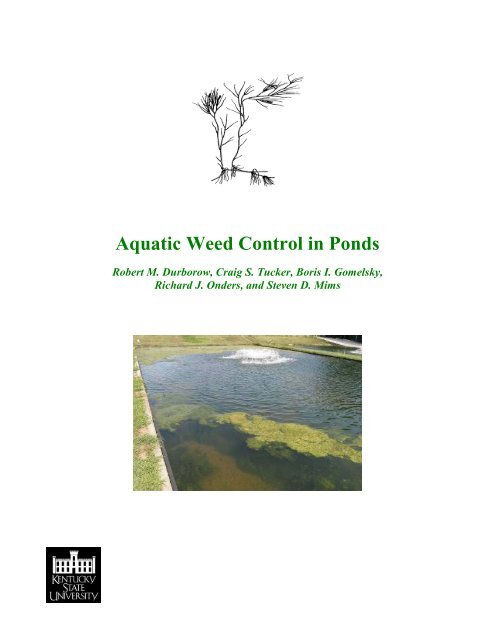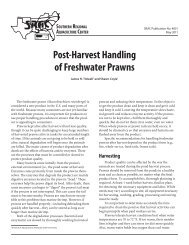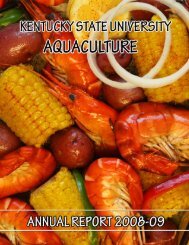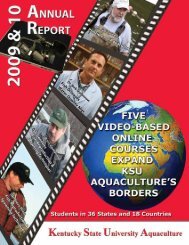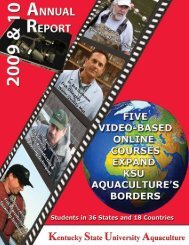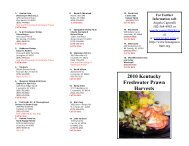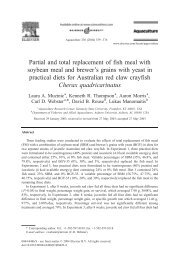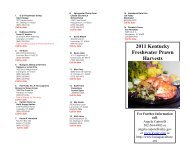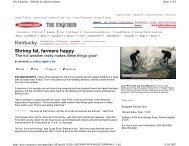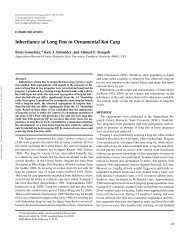Aquatic Weed Control in Ponds - Aquaculture at Kentucky State ...
Aquatic Weed Control in Ponds - Aquaculture at Kentucky State ...
Aquatic Weed Control in Ponds - Aquaculture at Kentucky State ...
You also want an ePaper? Increase the reach of your titles
YUMPU automatically turns print PDFs into web optimized ePapers that Google loves.
<strong>Aqu<strong>at</strong>ic</strong> <strong>Weed</strong> <strong>Control</strong> <strong>in</strong> <strong>Ponds</strong>Robert M. Durborow, Craig S. Tucker, Boris I. Gomelsky,Richard J. Onders, and Steven D. Mims
Robert M. Durborow, Ph.D., ProfessorSt<strong>at</strong>e Extension Specialist for <strong>Aquaculture</strong><strong>Aquaculture</strong> Center, <strong>Kentucky</strong> St<strong>at</strong>e UniversityFrankfort, <strong>Kentucky</strong> 40601Telephone: (502) 597-6581Fax: (502) 597-8118Email: robert.durborow@kysu.eduCraig S. Tucker, Ph.D., ProfessorDirector of Southern Regional <strong>Aquaculture</strong> CenterDelta Research and Extension CenterMississippi St<strong>at</strong>e UniversityStoneville, Mississippi 36842Boris I. Gomelsky, Ph.D., Associ<strong>at</strong>e Professor<strong>Aquaculture</strong> Center<strong>Kentucky</strong> St<strong>at</strong>e UniversityFrankfort, KY 40601Richard J. Onders, Research Co-<strong>in</strong>vestig<strong>at</strong>or<strong>Aquaculture</strong> Center<strong>Kentucky</strong> St<strong>at</strong>e UniversityFrankfort, KY 40601Steven D. Mims, Ph.D., Professor<strong>Aquaculture</strong> Center<strong>Kentucky</strong> St<strong>at</strong>e UniversityFrankfort, KY 406012
<strong>Aqu<strong>at</strong>ic</strong> <strong>Weed</strong> <strong>Control</strong> <strong>in</strong> <strong>Ponds</strong>Bob Durborow, Craig Tucker, BorisGomelsky, Rick Onders and Steve Mims<strong>Ponds</strong> are ideal habit<strong>at</strong>s foraqu<strong>at</strong>ic plants, and some will always bepresent. Plants are a necessarycomponent of pond ecosystems becausethey perform valuable functions.Photosynthesiz<strong>in</strong>g plants produceoxygen th<strong>at</strong> is needed to susta<strong>in</strong> fish life.Also, plants assimil<strong>at</strong>e ammonia th<strong>at</strong> isexcreted by fish thereby help<strong>in</strong>g toprevent accumul<strong>at</strong>ion of potentially toxicconcentr<strong>at</strong>ions of ammonia.Nevertheless, plants can cause problems<strong>in</strong> ponds and control measures oftenmust be used to elim<strong>in</strong><strong>at</strong>e or reduce theirabundance.Types of weedsThe plants th<strong>at</strong> grow <strong>in</strong> pondscan be c<strong>at</strong>egorized <strong>in</strong>to two groups. Thealgae are primitive plants th<strong>at</strong> have notrue roots, stems, or leaves, and do notproduce flowers or seeds. Algae can bec<strong>at</strong>egorized as phytoplankton orfilamentous algae.The higher aqu<strong>at</strong>ic plants aremore advanced, and usually have roots,stems, and leaves, and produce flowersand seeds. Higher aqu<strong>at</strong>ic plants caneither be submersed, emergent, orflo<strong>at</strong><strong>in</strong>g.AlgaePhytoplankton. These algae aremicroscopic simple plants suspended <strong>in</strong>w<strong>at</strong>er or form<strong>in</strong>g flo<strong>at</strong><strong>in</strong>g scums of nearmicroscopiccolonies on pond surfaces.Communities of phytoplankton arecalled the “bloom.” There are hundredsof species of phytoplankton, andidentific<strong>at</strong>ion of the different species isdifficult, requir<strong>in</strong>g a microscope.Phytoplankton are the mostcommon type of plant found <strong>in</strong> ponds.Moder<strong>at</strong>e densities of phytoplankton aredesirable <strong>in</strong> ponds because they shadethe pond bottom prevent<strong>in</strong>gestablishment of more troublesome typesof plants. Phytoplankton become a weedproblem when they become excessivelyabundant or when certa<strong>in</strong> undesirablespecies become dom<strong>in</strong>ant <strong>in</strong> thecommunity. Excessive phytoplanktonabundance causes serious w<strong>at</strong>er qualityproblems such as frequent periods ofdangerously low concentr<strong>at</strong>ions ofdissolved oxygen. This problem is oftenassoci<strong>at</strong>ed with dense blooms of bluegreenalgae (Figures 1 & 2). The bluegreenbloom flo<strong>at</strong>s to the top of the pondform<strong>in</strong>g a scum th<strong>at</strong> can block sunlightand prevent proper photosynthesis.These blooms can also cause an offflavorproblem <strong>in</strong> fish raised <strong>in</strong>aquaculture ponds.Figure 1. Blue-green algae(cyanobacteria) form<strong>in</strong>g a surface scum.Figure 2. Blue-green algae flo<strong>at</strong><strong>in</strong>g on apond surface.3
Filamentous algae. Mostfilamentous algae beg<strong>in</strong> grow<strong>in</strong>g on thebottom of the pond and rise to thesurface when gas bubbles becomeentrapped <strong>in</strong> the plant mass. They formm<strong>at</strong>s of cottony or slimy plant m<strong>at</strong>erial.These filamentous algae are also knownas “pond scum” or more commonly“moss.” However, one type offilamentous algae, Chara spp.,resembles submersed higher plants <strong>in</strong>growth habit. It is weakly anchored <strong>in</strong>the mud and grows up through the w<strong>at</strong>er.Positive identific<strong>at</strong>ion of the differenttypes of filamentous algae usuallyrequires a microscope. <strong>Control</strong> methodsare similar for all filamentous algaeexcept Pithophora spp., which is veryresistant to most copper-based algicidesand requires special tre<strong>at</strong>ment. It is thusimportant to identify the species offilamentous algae present <strong>in</strong> the pond toensure the proper tre<strong>at</strong>ment is selected.The most common filamentous algae <strong>in</strong>ponds are:Hydrodictyon spp. (w<strong>at</strong>ernet) – each cellis <strong>at</strong>tached repe<strong>at</strong>edly to two othersform<strong>in</strong>g a repe<strong>at</strong><strong>in</strong>g network of 5 or 6-sided mesh th<strong>at</strong> looks like a “fish net”stock<strong>in</strong>g (Figure 3).Figure 3. Microscopic view of w<strong>at</strong>er net(Hydrodictyon sp.). Photo from theInternet.Spirogyra spp. – usually a dark greenslimy mass th<strong>at</strong> can be pulled apart anddrawn out <strong>in</strong>to f<strong>in</strong>e filaments (Figure 4).This algae usually is easy to identifymicroscopically because the chloroplastis spiraled <strong>in</strong> a characteristic“corkscrew” along the <strong>in</strong>side of the cellwall (Figure 5).Figure 4. The filamentous algae,Spirogyra sp. is slick and slimy andpersists <strong>in</strong> ponds throughout the w<strong>in</strong>ter.It often goes away <strong>in</strong> hot summertemper<strong>at</strong>ures.Figure 5. Spiraled chloroplast <strong>in</strong>microscopic photograph of Spirogyra sp.Pithophora spp. – probably the mostnoxious and difficult filamentous algaeto control. Pithophora spp. is irregularlybranched, not slimy, and somewh<strong>at</strong>coarser than masses of Spirogyra spp. Amass of Pithophora spp. feels like wetwool to the touch (Figure 6). Thedist<strong>in</strong>guish<strong>in</strong>g microscopic characteristicis the presence of barrel-shaped sporesalong the filament (Figure 7).4
Figure 6. The filamentous algae,Pithophora sp. is more coarse (like wetwool) compared to Spirogyra sp. It isvery difficult to control chemically.Figure 7. Microscopic photograph of theterm<strong>in</strong>al of a filament of Pithophora sp.show<strong>in</strong>g the dark, swollen spores th<strong>at</strong>are characteristic of the genus.Chara spp. – a more advanced group ofalgae which resembles submersed higherplants <strong>in</strong> growth habit. This plant iscommonly called “muskgrass” becauseof the garlic or skunk-like odor releasedwhen it is crushed. Masses of Chara spp.are serr<strong>at</strong>ed and feel rough or crustywhen crushed <strong>in</strong> the hand (Figure 8).Figure 8. Muskgrass (Chara sp.) Photofrom University of Arizona.Filamentous algae areaesthetically undesirable, giv<strong>in</strong>g thepond a “clogged-up” overgrownappearance, and they <strong>in</strong>terfere withfish<strong>in</strong>g by snagg<strong>in</strong>g the fisherman’shook. In aquaculture, filamentous algaecan prevent fish or shrimp from be<strong>in</strong>gharvested by se<strong>in</strong>e nets. Se<strong>in</strong>es may rideup over the mass of weeds, allow<strong>in</strong>g fishto escape, and the weight of plantm<strong>at</strong>erial caught <strong>in</strong> the se<strong>in</strong>e may stra<strong>in</strong>equipment or completely stop theharvest<strong>in</strong>g process. Even if se<strong>in</strong><strong>in</strong>g ispossible, fish or shrimp may becomeentangled <strong>in</strong> the mass of weeds <strong>in</strong> these<strong>in</strong>e and will be stressed as workerspick through the weeds to recover them.This is particularly a problem withf<strong>in</strong>gerl<strong>in</strong>gs and shrimp.Higher aqu<strong>at</strong>ic plantsSubmersed plants. Submersedplants spend their entire lifetime bene<strong>at</strong>hthe surface of the w<strong>at</strong>er, although theflower may extend above the surface.Usually the plants are rooted <strong>in</strong> the mud,but masses of plants may tear loose andflo<strong>at</strong> free <strong>in</strong> the w<strong>at</strong>er. These plants areobjectionable because they <strong>in</strong>terfere withfish<strong>in</strong>g and fish harvest. The mostcommon submersed higher aqu<strong>at</strong>icplants <strong>in</strong> ponds are:Najas guadalupensis (bushy pondweed)– rooted, submersed plants with slenderbranch<strong>in</strong>g stems and narrow ribbon-likeleaves arranged opposite or <strong>in</strong> whorls ofthree. Bushy pondweed is a commonsubmersed weed problem <strong>in</strong> ponds(Figure 9).5
Figure 9. Bushy pondweed (Najas sp.) isa submersed aqu<strong>at</strong>ic plant.Potamogeton pect<strong>in</strong><strong>at</strong>us (sagopondweed) – rooted, wholly submersedplants with long, narrow leaves taper<strong>in</strong>gto a po<strong>in</strong>t. The stems are irregularly (andoften highly) branched (Figure 10).Figure 10. Sago pondweed(Potamogeton pect<strong>in</strong><strong>at</strong>us) is a submersedplant with long ribbony leaves.Cer<strong>at</strong>ophyllum demersum (coontail) –these plants have long th<strong>in</strong> stems whichare not rooted. The leaves are <strong>in</strong> whorlsand are forked (Figure 11).Figure 11. Coontail (Cer<strong>at</strong>ophyllumdemersum) is a submersed aqu<strong>at</strong>ic plant.Photo from U. of Florida on the Internet.Emergent plants. Emergentaqu<strong>at</strong>ic plants are rooted <strong>in</strong> the bottommud and grow above the w<strong>at</strong>er. Manycan also grow under strictly terrestrialconditions. The plants are rigid and notdependent on the w<strong>at</strong>er for support.Emergent plants usually <strong>in</strong>fest only thepond marg<strong>in</strong>s and other shallow areasresult<strong>in</strong>g from <strong>in</strong>adequ<strong>at</strong>e pondconstruction, w<strong>at</strong>er-shortage conditions,or excessive bank erosion. If stands ofemergent plants become too dense orwidespread, they may <strong>in</strong>terfere withfish<strong>in</strong>g, se<strong>in</strong><strong>in</strong>g or feed<strong>in</strong>g of fish. Theycan also cre<strong>at</strong>e a habit<strong>at</strong> th<strong>at</strong> harborssnakes. Fast-grow<strong>in</strong>g emergent plantssuch as smartweed (Polygonumpennsylvanicum) <strong>in</strong>habit shallow areasquickly and can often outpace the ris<strong>in</strong>gw<strong>at</strong>er level when ponds fill slowly (e.g.dur<strong>in</strong>g dry seasons or if only a slowflow<strong>in</strong>gwell is available to fill thepond).The most common emergentweeds <strong>in</strong> ponds are:6
Polygonum spp. (smartweed) – leavesare altern<strong>at</strong>e and elliptical on this plant.The stem is erect and jo<strong>in</strong>ted, with eachswollen node covered by a th<strong>in</strong> she<strong>at</strong>h.Flowers are usually white or p<strong>in</strong>k(Figure 12).Figure 14. Willows (Salix sp.) grow onthe pond’s edge and get <strong>in</strong> the way ofse<strong>in</strong><strong>in</strong>g and other pond oper<strong>at</strong>ions.Figure 12. Smartweed (Polygonum sp.)<strong>in</strong>habits shallow areas of ponds.Typha spp. (c<strong>at</strong>tails) – c<strong>at</strong>tails arefamiliar plants with stout, erect stems upto 8 feet tall. Leaves are stout, long, fl<strong>at</strong>and ribbon-like. The flowers are brownand cigar-shaped (Figure 13).Flo<strong>at</strong><strong>in</strong>g plants. This c<strong>at</strong>egory<strong>in</strong>cludes free-flo<strong>at</strong><strong>in</strong>g plants such asduckweeds (Figure 15) and w<strong>at</strong>ermeal(Figure 16), and flo<strong>at</strong><strong>in</strong>g-leaf plants,such as w<strong>at</strong>er lilies. Many flo<strong>at</strong><strong>in</strong>g plantsare present only when pond w<strong>at</strong>ers arerel<strong>at</strong>ively stagnant and sheltered fromw<strong>in</strong>ds. Small recre<strong>at</strong>ional ponds oftenhave problems with duckweed (Lemnaspp.) and w<strong>at</strong>ermeal (Wolffia spp.). Inaquaculture ponds, on the other hand,periodic dra<strong>in</strong><strong>in</strong>g and refill<strong>in</strong>g, andfrequent fish harvest activity makeconditions unfavorable for these plants;these larger ponds are often unshelteredfrom the w<strong>in</strong>d, and duckweeds arecont<strong>in</strong>ually washed ashore where theydry up and die.Figure 13. C<strong>at</strong>tails (Typha sp.) growalong a pond’s edge <strong>in</strong> shallow w<strong>at</strong>er.Salix spp. (willows) – shrubs or treeswith simple, elliptical leaves <strong>in</strong> altern<strong>at</strong>earrangement (Figure 14).Figure 15. Duckweed (Lemna sp.) hassmall leaves and roots.7
Figure 16. W<strong>at</strong>ermeal (Wolffia sp.) feelsgra<strong>in</strong>y like corn meal. Photo from TexasA&M University on the Internet.Occurrence of weed problemsSome plant life will always bepresent <strong>in</strong> ponds, but the type of aqu<strong>at</strong>icplant community th<strong>at</strong> becomesestablished <strong>in</strong> a pond depends on therel<strong>at</strong>ive abilities of particular plants tocompete for resources. The growth ofphytoplankton is favored <strong>in</strong> w<strong>at</strong>ers withhigh concentr<strong>at</strong>ions of nitrogen,phosphorus, and other plant nutrientsdissolved <strong>in</strong> the w<strong>at</strong>er. Phytoplanktonare efficient <strong>at</strong> us<strong>in</strong>g dissolved nutrientsand reproduce rapidly. Once established,the phytoplankton community competeseffectively for nutrients and also restrictsthe penetr<strong>at</strong>ion of light so th<strong>at</strong> plants th<strong>at</strong>germ<strong>in</strong><strong>at</strong>e on the bottom do not receiveenough light to cont<strong>in</strong>ue grow<strong>in</strong>g.Rooted submersed plants tend toestablish <strong>in</strong> ponds with low supplies ofnutrients <strong>in</strong> the w<strong>at</strong>er. These ponds oftenare clear with light penetr<strong>at</strong><strong>in</strong>g to thebottom, and rooted plants can use thenutrients <strong>in</strong> the bottom mud for growth.Established stands of submersed weedscompete for nutrients and light andprevent phytoplankton from becom<strong>in</strong>gestablished. Some submersed plants alsoproduce chemicals th<strong>at</strong> <strong>in</strong>hibit thegrowth of phytoplankton.Emergent plants usually colonizeonly the marg<strong>in</strong>s of ponds where thew<strong>at</strong>er is less than 2 to 3 feet deep. Iflevees or banks of the pond are erodedand have large areas of shallow w<strong>at</strong>er,expansive growths of emergent plantsmay be present. Emergent plants arerooted and can use nutrients <strong>in</strong> the mud.Thus, their establishment is also favoredby low nutrient levels <strong>in</strong> the w<strong>at</strong>er.<strong>Aquaculture</strong> ponds conta<strong>in</strong><strong>in</strong>gfood-sized fish receive high levels ofnutrients from daily feed<strong>in</strong>g offormul<strong>at</strong>ed fish food. These ponds,therefore, rarely have submersed oremergent aqu<strong>at</strong>ic weed problems; thenutrients <strong>in</strong> the w<strong>at</strong>er promote anactively grow<strong>in</strong>g phytoplankton bloomwhich, <strong>in</strong> turn, shades the pond bottomand prevents weed growth. <strong>Aquaculture</strong>f<strong>in</strong>gerl<strong>in</strong>g production ponds, on theother hand, receive fairly low levels ofnutrients because of the smaller biomassof fish; these ponds are much morelikely to have a scant phytoplanktonbloom and a problem with macrophyticplant growth such as submersed andemergent weeds. Likewise, recre<strong>at</strong>ionalponds, especially ones th<strong>at</strong> are notfertilized, also have a tendency to havean <strong>in</strong>adequ<strong>at</strong>e bloom and a macrophyticweed problem such as Najas spp. (bushypondweed).Environmentally-sound and costeffectiveaqu<strong>at</strong>ic weed managementdepends on the type of plant, the extentof plant coverage, the species and lifestageof fish or crustaceans <strong>in</strong> the pond,w<strong>at</strong>er quality, time of year, and we<strong>at</strong>her.Understand<strong>in</strong>g these <strong>in</strong>teractions, whichdiffer for each weed problem, is largelya m<strong>at</strong>ter of experience. Until th<strong>at</strong>experience is ga<strong>in</strong>ed, seek advice frompriv<strong>at</strong>e consultants or experts <strong>at</strong>universities.8
Prevention of aqu<strong>at</strong>ic weedsAlmost any plant can be toler<strong>at</strong>edas long as it does not become soabundant th<strong>at</strong> it <strong>in</strong>terferes with the<strong>in</strong>tended use of the pond. It is, however,difficult to predict whether a small<strong>in</strong>fest<strong>at</strong>ion of weeds will spread andbecome a problem, so most controlmeasures are implemented when fairlylarge stands of weeds have alreadybecome established. At th<strong>at</strong> time, us<strong>in</strong>gherbicides is usually the fastest way toeradic<strong>at</strong>e weeds and re-establish aphytoplankton bloom, which is usuallythe most desirable plant form <strong>in</strong> ponds.Chemical weed control is, however,risky <strong>in</strong> fish ponds because w<strong>at</strong>er qualitydeterior<strong>at</strong>es when dense stands of weedsare killed. Prevention of weeds is apreferred approach to aqu<strong>at</strong>ic plantmanagement.Certa<strong>in</strong> management procedurescan be used to m<strong>in</strong>imize the chances of<strong>in</strong>fest<strong>at</strong>ions of submersed and emergentplants and filamentous algae. Suchprocedures should become part ofcommon pond management and mayhelp avoid the use of chemical controlmeasures.Pond construction. Mostnoxious weed growth starts <strong>in</strong> theshallow (less than 2 ½ feet deep) areasof ponds. If the area of the pond wherelight can penetr<strong>at</strong>e to the bottom isreduced, rooted plants have less chanceto become established. Pond leveesand/or dams should have a fairly abruptslope of about 3:1 (3 feet out toward thecenter of the pond for every 1 foot droptoward the pond bottom) or 4:1. A slopeof gre<strong>at</strong>er th<strong>at</strong> 4:1 would be too gradualand would cre<strong>at</strong>e excessive shallow area,while a slope of less than 3:1 would betoo steep mak<strong>in</strong>g the levee prone toerosion and slough<strong>in</strong>g-off. Plans shouldbe made dur<strong>in</strong>g construction for theshallowest part of the pond to be noshallower than 2 ½ feet when the pond isclose to full (near the top of the dra<strong>in</strong>pipe).Refill<strong>in</strong>g an empty pond. Inmany cases a newly constructed pondwill be completed by the end of summer(by the time the dry period of the yearends). The ra<strong>in</strong>iest part of the yeartypically will occur dur<strong>in</strong>g fall andw<strong>in</strong>ter, and the new pond will fill fromra<strong>in</strong> run-off from the w<strong>at</strong>ershed dur<strong>in</strong>g <strong>at</strong>ime when weeds are less likely to grow.<strong>Ponds</strong> with a well w<strong>at</strong>er source areideally filled dur<strong>in</strong>g w<strong>in</strong>ter for this samereason. If they are filled dur<strong>in</strong>g othertimes, it is best to fill the pond as quicklyas possible from the well to <strong>at</strong>ta<strong>in</strong> anadequ<strong>at</strong>e w<strong>at</strong>er depth th<strong>at</strong> will preventaqu<strong>at</strong>ic weed growth. (If one well servesfour ponds, for example, one pondshould be filled <strong>at</strong> a time to m<strong>in</strong>imize thetime needed to get the proper depth forweed control). Also, grass carp may bestocked to prevent growth of nuisanceweeds. About seven triploid grass carpper acre is a good preventive stock<strong>in</strong>gr<strong>at</strong>e. In addition, ponds can be left emptyuntil the farmer plans to actually stockand beg<strong>in</strong> feed<strong>in</strong>g his fish unless thepond is made of highly structured clay(stereotypically red clay); <strong>in</strong> this case,allow<strong>in</strong>g the pond to dry out wouldpromote deep crack<strong>in</strong>g of the pond’sclay l<strong>in</strong><strong>in</strong>g which could cause leakswhen the farmer <strong>at</strong>tempts to refill thepond <strong>at</strong> a l<strong>at</strong>er d<strong>at</strong>e. If w<strong>at</strong>er needs to bema<strong>in</strong>ta<strong>in</strong>ed <strong>in</strong> a pond, a fertiliz<strong>at</strong>ionprogram can help to prevent the w<strong>at</strong>erfrom be<strong>in</strong>g clear. Fertiliz<strong>at</strong>ion promotesa healthy phytoplankton bloom th<strong>at</strong> willshade out sunlight from reach<strong>in</strong>gpotential weeds <strong>at</strong>tempt<strong>in</strong>g to germ<strong>in</strong><strong>at</strong>e<strong>at</strong> the bottom of the pond.Fertiliz<strong>at</strong>ion. Theimplement<strong>at</strong>ion and cont<strong>in</strong>ued use of the9
proper fertiliz<strong>at</strong>ion program is perhapsthe best method of prevent<strong>in</strong>g the growthof troublesome weeds <strong>in</strong> recre<strong>at</strong>ionponds as well as fry nursery ponds. Toavoid weed problems, establish aphytoplankton bloom as quickly aspossible after fill<strong>in</strong>g the ponds. The bestway to do this is to add <strong>in</strong>organicfertilizers to the pond. The key<strong>in</strong>gredient <strong>in</strong> fish pond fertilizers isphosphorus. The most commonphosphorus source <strong>in</strong> bagged, granularfertilizers is triple superphosph<strong>at</strong>e (0-46-0). It should be noted, however, th<strong>at</strong>when triple superphosph<strong>at</strong>e is broadcastover ponds, it settles to the bottombecause the granules are very <strong>in</strong>soluble.Most of the phosphorus reacts with thebottom mud and never reaches the w<strong>at</strong>er.Any phosphorus th<strong>at</strong> dissolves while thegranules settle through the w<strong>at</strong>er quicklyreacts with calcium <strong>in</strong> the w<strong>at</strong>er and ischanged <strong>in</strong>to unavailable calciumphosph<strong>at</strong>e. Granular fertilizers shouldbe put on an underw<strong>at</strong>er pl<strong>at</strong>form or <strong>in</strong> aporous conta<strong>in</strong>er so they can dissolveslowly <strong>in</strong>to the w<strong>at</strong>er before they contactthe mud bottom.Liquid fertilizers are moreeffective than granular fertilizers <strong>at</strong>stimul<strong>at</strong><strong>in</strong>g a phytoplankton bloom,especially <strong>in</strong> hard, alkal<strong>in</strong>e w<strong>at</strong>ers. Thephosphorus <strong>in</strong> liquid fertilizers is already<strong>in</strong> solution and immedi<strong>at</strong>ely available foruptake by the phytoplankton. Althoughthe phosphorus from liquid fertilizersalso will eventually become unavailabledue to reactions with calcium <strong>in</strong> thepond w<strong>at</strong>er, it rema<strong>in</strong>s <strong>in</strong> solution longenough to be taken up <strong>in</strong> adequ<strong>at</strong>equantities by the phytoplankton.The most common, and best,analysis for liquid fertilizers runs fromabout 10-34-0 to 13-38-0. This generalanalysis of about three times as muchphosphorus (expressed as P 2 O 5 ) asnitrogen (expressed as N) has beenfound to have an excellent balance. Ther<strong>at</strong>e used successfully by manycommercial fish producers is about 1quart per acre applied every other dayfor 3 to 14 days or until a noticeablephytoplankton bloom develops. Liquidfertilizer is heavier than w<strong>at</strong>er, so itshould first be diluted <strong>in</strong> w<strong>at</strong>er before itis applied to the pond, prevent<strong>in</strong>g it froms<strong>in</strong>k<strong>in</strong>g <strong>in</strong>to the bottom mud. It can besprayed from the bank or applied from abo<strong>at</strong> outfitted for chemical applic<strong>at</strong>ions.It should be noted th<strong>at</strong> excessivew<strong>at</strong>er flow through ponds flushes plantnutrients from the w<strong>at</strong>er, favor<strong>in</strong>g rootedweeds th<strong>at</strong> can obta<strong>in</strong> nutrients frombottom soils. <strong>Ponds</strong> should not havew<strong>at</strong>ershed areas larger than necessary toma<strong>in</strong>ta<strong>in</strong> w<strong>at</strong>er level; excess runoff fromlarge w<strong>at</strong>ersheds should be divertedaway from ponds. Spr<strong>in</strong>gs runn<strong>in</strong>g <strong>in</strong>toponds can also dilute nutrients, and theytoo can be diverted away from the pondand can be allowed to enter the pondonly when w<strong>at</strong>er is needed.Manual harvest<strong>in</strong>g. Remov<strong>in</strong>gpotentially noxious emergent weeds byhand is another management practiceth<strong>at</strong> may reduce the possibility of hav<strong>in</strong>gto use chemicals. As small areas of thepond marg<strong>in</strong> become <strong>in</strong>fested, plants areremoved manually. Manual harvest<strong>in</strong>gof weeds is only suited for controll<strong>in</strong>gemergent veget<strong>at</strong>ion <strong>in</strong> rel<strong>at</strong>ively smallponds. Care should be taken to removeas much of the rootstock or rhizome aspossible to m<strong>in</strong>imize re-growth.Mechanical removal of filamentousalgae or submersed plants almost alwaysproves to be futile.Rout<strong>in</strong>e mow<strong>in</strong>g of pond bankswill help prevent the establishment ofdense growths of shorel<strong>in</strong>e plants suchas willows and will also reduce habit<strong>at</strong>for snakes.10
W<strong>at</strong>er draw-downs. Periodicw<strong>at</strong>er draw-downs are sometimeseffective <strong>in</strong> kill<strong>in</strong>g or prevent<strong>in</strong>g aqu<strong>at</strong>icweeds. The veget<strong>at</strong>ion along the pondmarg<strong>in</strong> (the most common loc<strong>at</strong>ion forweed problems) is stranded and diesfrom dry<strong>in</strong>g up.Biological control of aqu<strong>at</strong>icplantsBiological weed control <strong>in</strong> ponds<strong>in</strong>volves the use of fish to consumeunwanted aqu<strong>at</strong>ic veget<strong>at</strong>ion. Grass carpare normally used <strong>in</strong> warmw<strong>at</strong>er ponds.They are most often used to controlsubmersed plants or filamentous algae.Koi (colorful common carp, Cypr<strong>in</strong>uscarpio koi) are presently be<strong>in</strong>g evalu<strong>at</strong>ed<strong>at</strong> <strong>Kentucky</strong> St<strong>at</strong>e University for theirweed prevention potential.Grass carp. The grass carp or“white amur” (Ctenopharyngodon idella,Figure 17) was <strong>in</strong>troduced <strong>in</strong>to theUnited St<strong>at</strong>es from Southeast Asia <strong>in</strong>1963 and is now widespread especially<strong>in</strong> the southeastern st<strong>at</strong>es. The fish isbanned <strong>in</strong> many st<strong>at</strong>es and some st<strong>at</strong>esallow only sterile, triploid grass carp.Where legal and available, this fish is avaluable tool to control nuisance aqu<strong>at</strong>icweeds.Figure 17. Triploid grass carp f<strong>in</strong>gerl<strong>in</strong>g(Ctenopharyngodon idella).The controversy over thedistribution and use of grass carp isbased on the potential effect of this fishon n<strong>at</strong>ive fish and wildlife.Considerable discretion shouldbe used when plann<strong>in</strong>g to stock thesefish <strong>in</strong>to ponds and every effort shouldbe made to prevent their escape <strong>in</strong>ton<strong>at</strong>ural w<strong>at</strong>ers. To further dim<strong>in</strong>ish thelikelihood th<strong>at</strong> th<strong>at</strong> grass carp willreproduce and thrive <strong>in</strong> n<strong>at</strong>ural w<strong>at</strong>ers, itis recommended th<strong>at</strong> only sterile, triploidcarp be used.The grass carp has several traitsth<strong>at</strong> make it a good species forrecre<strong>at</strong>ional ponds and for polycultur<strong>in</strong>gwith channel c<strong>at</strong>fish. Small grass carp(less than 1-2 pounds) are almostcompletely herbivorous and will notcompete to a significant degree withc<strong>at</strong>fish for feed. Grass carp toler<strong>at</strong>e awide range of environmental conditions:they can survive <strong>at</strong> w<strong>at</strong>er temper<strong>at</strong>ures of32º to 105º F and are nearly as tolerantas c<strong>at</strong>fish to low dissolved oxygenconcentr<strong>at</strong>ions. The fish grows rapidly,as much as 5 to 10 pounds a year. Itmust consume large quantities of plantm<strong>at</strong>erial to grow and may consume 2 to3 times its weight <strong>in</strong> plant m<strong>at</strong>erial perday.Grass carp prefer to e<strong>at</strong> succulentsubmersed plants such as Najas spp. andChara spp. Fibrous plants such asgrasses and smartweed are less preferredand grass carp will not e<strong>at</strong> these plants ifmore preferred plants are available.Food consumption by grass carp isgre<strong>at</strong>est <strong>at</strong> w<strong>at</strong>er temper<strong>at</strong>ures of 80º to85º F, and the fish stops e<strong>at</strong><strong>in</strong>g when thetemper<strong>at</strong>ure falls below about 55º F.In c<strong>at</strong>fish nursery ponds, grasscarp should be stocked prior to stock<strong>in</strong>gthe c<strong>at</strong>fish fry <strong>in</strong> order to prevent weedgrowth. Likewise, <strong>in</strong> recre<strong>at</strong>ional ponds,11
grass carp should be stocked beforeweeds become a problem.Grass carp also are used by somepond owners to control exist<strong>in</strong>g weeds.However, considerable time is requiredfor grass carp to reduce weed<strong>in</strong>fest<strong>at</strong>ions, particularly if coverage isextensive. Results may take a year to berealized. Food-fish ponds are usuallynot dra<strong>in</strong>ed each year and grass carpbecome a permanent <strong>in</strong>habitant of thepond. Larger grass carp learn to feed onpelleted feeds and often do little tocontrol weeds <strong>in</strong> the second or third yearthey are present. Usually weedproblems have been controlled by thistime and a phytoplankton communityhas developed which prevents furtherweed growth.The stock<strong>in</strong>g r<strong>at</strong>e for grass carpdepends on the severity of the weedproblem. When used to prevent theestablishment of submersed weeds, 5-10small (3-6 <strong>in</strong>ch) carp per acre should bestocked. The same stock<strong>in</strong>g r<strong>at</strong>e is alsoadequ<strong>at</strong>e if the pond is lightly <strong>in</strong>festedwith weeds. For more severe weedproblems, 10-15 fish per acre should bestocked. For heavily weed <strong>in</strong>festedponds, stock<strong>in</strong>g r<strong>at</strong>es can be <strong>in</strong>creased to15-25 per acre or gre<strong>at</strong>er. Grass carpmust be stocked <strong>at</strong> a size large enough toprevent them from be<strong>in</strong>g e<strong>at</strong>en bypred<strong>at</strong>or fish such as bass and largec<strong>at</strong>fish.Koi. Koi have been shown toreduce the occurrence of submersedaqu<strong>at</strong>ic weeds and filamentous algae bykeep<strong>in</strong>g pond w<strong>at</strong>er turbid. The turbiditymay be caused by their activity <strong>in</strong> thepond bottom which keeps the mudsuspended <strong>in</strong> the w<strong>at</strong>er column andreleases nutrients, supply<strong>in</strong>g a foodsource for the phytoplankton bloom. The“root<strong>in</strong>g-around” on the pond bottomalso prevents weeds from establish<strong>in</strong>gthere. Koi have been chosen foruniversity demonstr<strong>at</strong>ion projects overnon-colorful common carp because ofthe side benefits of hav<strong>in</strong>g an <strong>at</strong>tractiveaddition to the pond and a fish th<strong>at</strong> canbe marketed for its ornamental value(Figure 18). Cover photographs illustr<strong>at</strong>eponds without koi (front cover) andponds with koi (back cover) <strong>at</strong> <strong>Kentucky</strong>St<strong>at</strong>e University <strong>Aquaculture</strong> Center.Figure 18. Koi keep pond w<strong>at</strong>er turbidwhich reduces the occurrence ofnuisance aqu<strong>at</strong>ic weeds.<strong>Control</strong> of aqu<strong>at</strong>ic plants withherbicides<strong>Control</strong> of aqu<strong>at</strong>ic weeds withherbicides is the most common means oferadic<strong>at</strong><strong>in</strong>g weeds <strong>in</strong> ponds. Correctidentific<strong>at</strong>ion of weeds is criticalbecause potential impacts andmanagement differ for each plant.Str<strong>at</strong>egies effective on one species maybe <strong>in</strong>effective even on similar species. Inparticular, herbicides are selective (somemuch more than others), and effectivecontrol depends on m<strong>at</strong>ch<strong>in</strong>g the weedwith the most appropri<strong>at</strong>e herbicide.Priv<strong>at</strong>e consultants or experts <strong>at</strong> localuniversities can help identify the weedproblem.In the United St<strong>at</strong>es, registr<strong>at</strong>ionof chemicals for fishery use is granted12
y the Environmental Protection Agencyor the Food and Drug Adm<strong>in</strong>istr<strong>at</strong>ionunder the Federal Environment Pesticide<strong>Control</strong> Act (FEPCA) of 1972. The lackof registr<strong>at</strong>ion does not necessarily meanth<strong>at</strong> the chemical is harmful to theenvironment or th<strong>at</strong> it is extremely toxic.<strong>Aquaculture</strong> is considered a m<strong>in</strong>or useby most chemical companies, and theyare simply not will<strong>in</strong>g to spend the largeamount of money needed to compile thed<strong>at</strong>a necessary for registr<strong>at</strong>ion review.However, some unregistered herbicidesare toxic to fish or their use may result <strong>in</strong>chemical residues <strong>in</strong> the edible portionof the fish. For these reasons, onlyherbicides labeled for use <strong>in</strong> food-fishponds should be used by pond owners,and label <strong>in</strong>structions should be carefullyfollowed. Proper chemical usage canalso m<strong>in</strong>imize the effects on non-targetorganisms <strong>in</strong>side and outside the pond.Sk<strong>in</strong> and eye protection should be wornwhen work<strong>in</strong>g with all chemicals toprevent absorption <strong>in</strong>to the body.The follow<strong>in</strong>g herbicides orherbicide groups are labeled for use <strong>in</strong>food-fish ponds. The tables on pages 22and 23 summarize herbicide use forcommon weeds <strong>in</strong> fish ponds.Copper sulf<strong>at</strong>e (various tradenames). Copper sulf<strong>at</strong>e (CuSO 4 ∙5H 2 O;copper sulf<strong>at</strong>e pentahydr<strong>at</strong>e) is available<strong>in</strong> various particle sizes from f<strong>in</strong>epowder to large crystals. The f<strong>in</strong>epowder is more effective because itdissolves faster. Copper sulf<strong>at</strong>e shouldonly be used to control algae, becauser<strong>at</strong>es necessary to kill other plants mayalso be toxic to fish. The filamentousalgae, Pithophora spp., is resistant tocopper sulf<strong>at</strong>e. Most algae arecontrolled more effectively if tre<strong>at</strong>mentwith copper sulf<strong>at</strong>e is made soon afterplant growth has started.In soft w<strong>at</strong>ers of low alkal<strong>in</strong>ity,copper is extremely toxic to fish and it isrecommended th<strong>at</strong> copper sulf<strong>at</strong>e not beused <strong>in</strong> w<strong>at</strong>ers with a total alkal<strong>in</strong>ity ofless than 50 parts per million (ppm) asCaCO 3 . Copper sulf<strong>at</strong>e is less effectiveas an algicide <strong>in</strong> hard, alkal<strong>in</strong>e w<strong>at</strong>ersbecause the copper rapidly precipit<strong>at</strong>esout of solution. The tre<strong>at</strong>ment r<strong>at</strong>e<strong>in</strong>creases with total alkal<strong>in</strong>ity, and theformula used to calcul<strong>at</strong>e the tre<strong>at</strong>mentr<strong>at</strong>e is:ppm copper sulf<strong>at</strong>e = (ppm totalalkal<strong>in</strong>ity) ÷ 100.In w<strong>at</strong>ers with a total alkal<strong>in</strong>ity gre<strong>at</strong>erthan about 300 ppm as CaCO 3 , copperfrom copper sulf<strong>at</strong>e precipit<strong>at</strong>es out ofsolution so rapidly th<strong>at</strong> it is difficult toachieve an effective tre<strong>at</strong>ment.Use of copper sulf<strong>at</strong>e can lead todangerously low oxygen concentr<strong>at</strong>ions,especially <strong>in</strong> the summer. When tre<strong>at</strong><strong>in</strong>gfilamentous algae, the danger of lowdissolved oxygen concentr<strong>at</strong>ionsfollow<strong>in</strong>g tre<strong>at</strong>ment can be m<strong>in</strong>imizedby tre<strong>at</strong><strong>in</strong>g 1 / 3 to 1 / 2 of the w<strong>at</strong>er area <strong>at</strong> <strong>at</strong>ime and wait<strong>in</strong>g 10 to 14 days betweentre<strong>at</strong>ments.Dissolve the number of poundsof copper sulf<strong>at</strong>e to be used <strong>in</strong> <strong>at</strong> leastthe same number of gallons of w<strong>at</strong>erbefore apply<strong>in</strong>g to the pond (for<strong>in</strong>stance, dissolve 10 pounds of coppersulf<strong>at</strong>e <strong>in</strong> 10 gallons of w<strong>at</strong>er). It is bestto apply copper sulf<strong>at</strong>e <strong>in</strong> clear w<strong>at</strong>erabove 60º F and on a sunny day. Itshould also be noted th<strong>at</strong> putt<strong>in</strong>g coppersulf<strong>at</strong>e solution <strong>in</strong> galvanized conta<strong>in</strong>erscauses the copper to chemically displacethe galvanized l<strong>in</strong><strong>in</strong>g. This removescopper from the tre<strong>at</strong>ment solution.Chel<strong>at</strong>ed copper (Cutr<strong>in</strong>e-Plus,Clearig<strong>at</strong>e, Cutr<strong>in</strong>e-Ultra, K-Tea,Algimyc<strong>in</strong>, Komeen, Pondmaster,Nautique, Capta<strong>in</strong>). These herbicidesare available <strong>in</strong> both liquid and granular13
form, but the liquid is most commonlyused. The copper <strong>in</strong> these herbicides isbound <strong>in</strong> organic complexes so th<strong>at</strong> thecopper will not precipit<strong>at</strong>e out ofsolution as rapidly as uncomplexedcopper <strong>in</strong> hard, alkal<strong>in</strong>e w<strong>at</strong>ers. Cutr<strong>in</strong>e-Plus, for example, has a prolongedeffectiveness because its chel<strong>at</strong><strong>in</strong>g agent,ethanolam<strong>in</strong>e, decomposes slowly <strong>in</strong>sunlight. Although chel<strong>at</strong>ed copperherbicides usually are more effectivethan copper sulf<strong>at</strong>e, they areconsiderably more expensive to use.The table on page 21 of this booklet liststhe aqu<strong>at</strong>ic weeds controlled by each ofthe chel<strong>at</strong>ed copper compounds. Copperherbicides have a reput<strong>at</strong>ion foreffectively kill<strong>in</strong>g algae <strong>in</strong>clud<strong>in</strong>gphytoplankton, some filamentous algaeand Chara (musk grass) which is also analgae. However, Cutr<strong>in</strong>e-Ultra isspecially designed to kill Pithophorawith a penetr<strong>at</strong><strong>in</strong>g surfactant. AndKomeen, Pondmaster, Nautique, andCapta<strong>in</strong>, unlike many other chel<strong>at</strong>edcoppers, are able to control higheraqu<strong>at</strong>ic plants like Najas, coontail,Elodea and sago pondweed.Additionally, chel<strong>at</strong>ed coppersare often comb<strong>in</strong>ed with other herbicidessuch as Reward, Aqu<strong>at</strong>hol, or Sonar toenhance their effectiveness, and <strong>in</strong> somecases, reduce the amount needed of bothherbicides.Diqu<strong>at</strong> (Reward, <strong>Weed</strong>tr<strong>in</strong>e D).Diqu<strong>at</strong> is sold as a liquid conta<strong>in</strong><strong>in</strong>g 2pounds active <strong>in</strong>gredient per gallon. It isa wide-spectrum herbicide and willcontrol most filamentous algae <strong>in</strong>clud<strong>in</strong>gPithophora spp. and Chara spp.,submersed weeds such as Najas spp. andcoontail, and can be mixed with asurfactant and sprayed to controlemergent weeds such as c<strong>at</strong>tail. Diqu<strong>at</strong>should not be used <strong>in</strong> muddy w<strong>at</strong>er andmud should not be stirred up dur<strong>in</strong>gapplic<strong>at</strong>ion because diqu<strong>at</strong> will b<strong>in</strong>dtightly with clay particles suspended <strong>in</strong>the w<strong>at</strong>er render<strong>in</strong>g the herbicide<strong>in</strong>effective <strong>at</strong> controll<strong>in</strong>g plants grow<strong>in</strong>gbene<strong>at</strong>h the surface. Diqu<strong>at</strong> should beapplied on a sunny day to activelygrow<strong>in</strong>g weeds. Only 1 / 3 to 1 / 2 of thepond w<strong>at</strong>er area should be tre<strong>at</strong>ed <strong>at</strong> onetime with a 14-day <strong>in</strong>terval betweentre<strong>at</strong>ments. A 14-day withdrawal periodis required by law after diqu<strong>at</strong> use beforetre<strong>at</strong>ed w<strong>at</strong>er can be used for animalconsumption, swimm<strong>in</strong>g, spray<strong>in</strong>g,irrig<strong>at</strong>ion or dr<strong>in</strong>k<strong>in</strong>g.Endothall, dipotassium salt(Aqu<strong>at</strong>hol, Aqu<strong>at</strong>hol K, Aqu<strong>at</strong>holSuper K). The dipotassium salt ofendothall is available <strong>in</strong> liquid (Aqu<strong>at</strong>holK) or granular (Aqu<strong>at</strong>hol) form. It willnot kill algae but will control a widevariety of submersed higher plants,<strong>in</strong>clud<strong>in</strong>g Najas spp., coontail, andfanwort. The granular formul<strong>at</strong>ion isrel<strong>at</strong>ively expensive, but is particularlyeffective on Najas spp. Dipotassium saltof endothall is a contact killer. It issprayed onto or <strong>in</strong>jected below the w<strong>at</strong>ersurface and can be sprayed <strong>at</strong> highconcentr<strong>at</strong>ions directly on exposedweeds. For best results, w<strong>at</strong>ertemper<strong>at</strong>ures should be 65º F or above.When w<strong>at</strong>er temper<strong>at</strong>ures are high andan <strong>in</strong>creased danger of dissolved oxygendepletion exists, this herbicide should beapplied to 1 / 3 to 1 / 2 of the pond pertre<strong>at</strong>ment with a 5 to 7 day <strong>in</strong>tervalbetween tre<strong>at</strong>ment applic<strong>at</strong>ions.W<strong>at</strong>er tre<strong>at</strong>ed with granularAqu<strong>at</strong>hol must not be used for irrig<strong>at</strong>ionor for agricultural sprays on food cropsor for domestic purposes with<strong>in</strong> 7 daysof tre<strong>at</strong>ment. More detailed restrictionsexist for Aqu<strong>at</strong>hol K. It may not be usedfor the above mentioned purposes aswell as for w<strong>at</strong>er<strong>in</strong>g livestock for 7 daysafter apply<strong>in</strong>g it up to 0.5 ppm; for 1414
days after applic<strong>at</strong>ion up to 4.25 ppm;and for 25 days after applic<strong>at</strong>ion up to5.0 ppm. In addition, w<strong>at</strong>er tre<strong>at</strong>ed withAqu<strong>at</strong>hol K may not be used forswimm<strong>in</strong>g until 24 hours after tre<strong>at</strong>ment.Endothall, alkylam<strong>in</strong>e salt(Hydrothol 191). The alkylam<strong>in</strong>e saltof endothall (Hydrothol 191) is mostcommonly used <strong>in</strong> the liquidformul<strong>at</strong>ion. It is a more potentherbicide than the potassium salt(Aqu<strong>at</strong>hol K) and will control mostfilamentous algae <strong>in</strong>clud<strong>in</strong>g Pithophoraspp. and Chara spp. Repe<strong>at</strong> tre<strong>at</strong>mentsare recommended if algae growthreappears. Hydrothol 191 is a rel<strong>at</strong>ivelytoxic herbicide to fish and tre<strong>at</strong>mentr<strong>at</strong>es required to tre<strong>at</strong> submersed higherplants are generally too risky <strong>in</strong>commercial c<strong>at</strong>fish ponds to justify itsuse. When the herbicide is used to tre<strong>at</strong>filamentous algae, only a portion of thepond should be tre<strong>at</strong>ed <strong>at</strong> one time. Fishavoid the tre<strong>at</strong>ed area and are usually notkilled. Hydrothol 191 tre<strong>at</strong>ments as highas 0.3 ppm (often needed to killPithophora spp.) can be used, but higherr<strong>at</strong>es will kill fish.Fish <strong>in</strong> tre<strong>at</strong>ed w<strong>at</strong>ers may not beconsumed with<strong>in</strong> 3 days after tre<strong>at</strong>mentwith Hydrothol 191. Likewise, tre<strong>at</strong>edw<strong>at</strong>er should not be used for w<strong>at</strong>er<strong>in</strong>glivestock, prepar<strong>in</strong>g agricultural spraysfor food crops, irrig<strong>at</strong>ion, or domesticpurposes with<strong>in</strong> 7 days after applic<strong>at</strong>ionwhen up to 3.0 ppm Hydrothol 191 isused.Fluridone (Sonar, Avast).Fluridone is available as an aqueoussuspension or as slow-release (SRP),precision release (PR) and quick releasepellets. Fluridone will not killphytoplankton or filamentous algae, butcontrols a broad spectrum of submersedhigher plants. This herbicide is slowact<strong>in</strong>g, and results may take 30 to 90days to be noticeable. The slow kill<strong>in</strong>gaction (and thus slow weeddecomposition) helps to prevent lowdissolved oxygen th<strong>at</strong> typically resultsfrom rapidly decompos<strong>in</strong>g weeds.Usually with<strong>in</strong> 7 to 10 days of tre<strong>at</strong>mentthe grow<strong>in</strong>g po<strong>in</strong>ts of tre<strong>at</strong>ed plantsbecome white or p<strong>in</strong>k as a result ofchlorophyll photo degrad<strong>at</strong>ion. Sonarshould be applied to actively grow<strong>in</strong>gweeds, and the entire pond surfaceshould be tre<strong>at</strong>ed <strong>at</strong> once. Partial or spottre<strong>at</strong>ments result <strong>in</strong> dilution of theherbicide with the untre<strong>at</strong>ed w<strong>at</strong>er. Donot use tre<strong>at</strong>ed w<strong>at</strong>er for crop irrig<strong>at</strong>ionfor 30 days after applic<strong>at</strong>ion.2,4-D (Aquacide, Aqua-Kleen,<strong>Weed</strong>-Rhap, <strong>Weed</strong>tr<strong>in</strong>e II, etc.). Thisherbicide is formul<strong>at</strong>ed for aqu<strong>at</strong>ic use asthe dimethylam<strong>in</strong>e salt or isooctyl ester.It is available <strong>in</strong> liquid or granular form.The granular form is effective <strong>at</strong>controll<strong>in</strong>g submersed higher plants suchas Najas spp. and coontail. The liquidformul<strong>at</strong>ions of 2,4-D are most effective<strong>in</strong> spr<strong>in</strong>g when weeds start to grow.Acid pH (6 and below) enhances itsherbicidal activity while a pH of 8 orabove tends to make it less effective.Tre<strong>at</strong><strong>in</strong>g early <strong>in</strong> the morn<strong>in</strong>g when pHis usually lowest will <strong>in</strong>crease theeffectiveness of 2,4-D.Glyphos<strong>at</strong>e (Rodeo,Aquamaster, AquaPRO, etc.).Glyphos<strong>at</strong>e is sold as a liquid and is foruse mostly on emergent and shorel<strong>in</strong>eplants. The herbicide is mixed with asurfactant and sprayed on the veget<strong>at</strong>ion.Glyphos<strong>at</strong>e is a broad spectrumherbicide and is useful for the control ofc<strong>at</strong>tails, grasses, smartweed, and willowsaround pond marg<strong>in</strong>s. Applic<strong>at</strong>ion whenweeds are <strong>in</strong> the flower<strong>in</strong>g or fruit<strong>in</strong>gstage is more effective than earlierapplic<strong>at</strong>ion. Visible results (wilt<strong>in</strong>g andyellow<strong>in</strong>g) are usually not seen for 2 to 715
days after applic<strong>at</strong>ion. Ra<strong>in</strong>falloccurr<strong>in</strong>g with<strong>in</strong> 6 hours of applic<strong>at</strong>ionreduces the effectiveness of Rodeo.Imazapyr (Habit<strong>at</strong>, AquaPier).Imazapyr is a liquid herbicide th<strong>at</strong> ismixed with w<strong>at</strong>er and a surfactant orvegetable oil and sprayed on emergent orflo<strong>at</strong><strong>in</strong>g aqu<strong>at</strong>ic weeds. When sprayeddirectly onto emergent leaves, theherbicide is transloc<strong>at</strong>ed throughout theweed, concentr<strong>at</strong><strong>in</strong>g <strong>in</strong> the roots where itcauses the weed to die (which sometimestakes more than two weeks) and preventsfuture re-growth. Imazapyr is mosteffective if applied when the weed isactively grow<strong>in</strong>g. The effectiveness ofimazapyr is reduced if it ra<strong>in</strong>s with<strong>in</strong> anhour of applic<strong>at</strong>ion. The label notes th<strong>at</strong>“Habit<strong>at</strong> does not control plants whichare completely submerged or have amajority of their foliage under w<strong>at</strong>er.”Due to the risk of oxygendepletion from decompos<strong>in</strong>g weeds, nomore than half the pond’s surface areashould be tre<strong>at</strong>ed <strong>at</strong> one time, and <strong>at</strong>least 10 to 14 days should separ<strong>at</strong>etre<strong>at</strong>ments. An applic<strong>at</strong>or’s license isrequired to purchase and applyimazapyr. The most current herbicidedirections (found <strong>in</strong> the leaflet label<strong>at</strong>tached to the conta<strong>in</strong>er) shouldoverride any other tre<strong>at</strong>ment advice,<strong>in</strong>clud<strong>in</strong>g th<strong>at</strong> found <strong>in</strong> this booklet.Imazapyr is rel<strong>at</strong>ivelyenvironmentally safe. Tre<strong>at</strong>ed w<strong>at</strong>ershave no restrictions for recre<strong>at</strong>ion<strong>in</strong>clud<strong>in</strong>g swimm<strong>in</strong>g and fish<strong>in</strong>g or forlivestock consumption. However,imazapyr may not be applied to w<strong>at</strong>erwith<strong>in</strong> one-half mile upstream of anactive potable w<strong>at</strong>er <strong>in</strong>take.Triclopyr (Renov<strong>at</strong>e 3,Renov<strong>at</strong>e OTF, Garlon 3A). Renov<strong>at</strong>e3 is a liquid herbicide used to controlcerta<strong>in</strong> emergent, submersed andflo<strong>at</strong><strong>in</strong>g aqu<strong>at</strong>ic plants (<strong>in</strong>clud<strong>in</strong>gallig<strong>at</strong>orweed, milfoil, w<strong>at</strong>erhyac<strong>in</strong>th,w<strong>at</strong>erlily, and w<strong>at</strong>erprimrose) <strong>in</strong> bodiesof w<strong>at</strong>er th<strong>at</strong> have little or no cont<strong>in</strong>uousoutflow. Mix<strong>in</strong>g triclopyr with a nonionicsurfactant is recommended toimprove its effectiveness.Renov<strong>at</strong>e OTF (On TargetFlakes) settles directly on submersedweeds and, therefore, is effective <strong>at</strong>lower concentr<strong>at</strong>ions than liquidRenov<strong>at</strong>e 3. (60% less active <strong>in</strong>gredientcan be used when apply<strong>in</strong>g Renov<strong>at</strong>eOTF, mak<strong>in</strong>g it more environmentallyfriendly).Triclopyr tre<strong>at</strong>ed w<strong>at</strong>er shouldnot be used for irrig<strong>at</strong>ion for 120 daysunless the triclopyr is not detectable bylabor<strong>at</strong>ory analysis. The most currentherbicide directions (found <strong>in</strong> the leafletlabel <strong>at</strong>tached to the conta<strong>in</strong>er) shouldoverride any other tre<strong>at</strong>ment advice,<strong>in</strong>clud<strong>in</strong>g th<strong>at</strong> found <strong>in</strong> this booklet.Penoxsulam (Galleon SC).Galleon SC was approved for use as anaqu<strong>at</strong>ic herbicide on July 17, 2007. Itcontrols duckweed, w<strong>at</strong>er hyac<strong>in</strong>th,cabomba, egeria (elodea), Eurasianw<strong>at</strong>ermilfoil, hydrilla and sagopondweed.Galleon SC partially controlsweeds <strong>in</strong> the follow<strong>in</strong>g list. Depend<strong>in</strong>gon dosage, time of year, growth stage,applic<strong>at</strong>ion method and degree of w<strong>at</strong>ermovement, the weeds listed above canbe controlled while leav<strong>in</strong>g thefollow<strong>in</strong>g n<strong>at</strong>ive species unharmed. (Orhigher tre<strong>at</strong>ment r<strong>at</strong>es can be used tocontrol weeds <strong>in</strong> both lists). Partiallycontrolled weeds <strong>in</strong>clude w<strong>at</strong>ermeal,allig<strong>at</strong>orweed, arrowhead, parrotfe<strong>at</strong>her,smartweed, pondweed, najas andspikerush.A surfactant must be added whenemergent weeds are be<strong>in</strong>g controlled. Aswith Sonar, Galleon SC is very slowact<strong>in</strong>g and should be applied to the entire16
pond surface <strong>at</strong> once. (Partial or spottre<strong>at</strong>ments result <strong>in</strong> dilution of theherbicide with the untre<strong>at</strong>ed w<strong>at</strong>er).Galleon SC also can be applied as a preemergent<strong>in</strong> empty (dew<strong>at</strong>ered) ponds.Check a current label to get the exacttre<strong>at</strong>ment r<strong>at</strong>e for each type of weed.Sodium Carbon<strong>at</strong>ePeroxyhydr<strong>at</strong>e (GreenCleanPRO,Phycomyc<strong>in</strong>, Pak 27). SodiumCarbon<strong>at</strong>e Peroxyhydr<strong>at</strong>e (percarbon<strong>at</strong>e)is a granular algaecide/fungicide used totre<strong>at</strong>, control and prevent a broadspectrum of algae and fungi. For themost effective tre<strong>at</strong>ment, usepercarbon<strong>at</strong>e when algae growth firstappears, and tre<strong>at</strong> early <strong>in</strong> the day whensunny with little or no w<strong>in</strong>d. Flo<strong>at</strong><strong>in</strong>galgae m<strong>at</strong>s should be broken up beforeor dur<strong>in</strong>g tre<strong>at</strong>ment; and after tre<strong>at</strong>ment,dead algae can be removed from thew<strong>at</strong>er surface to prevent excessivenutrients from enter<strong>in</strong>g back <strong>in</strong>to thew<strong>at</strong>er (dur<strong>in</strong>g decomposition) andstimul<strong>at</strong><strong>in</strong>g subsequent heavyphytoplankton blooms. The BioSafeSystems’ technical bullet<strong>in</strong> po<strong>in</strong>ts outth<strong>at</strong> GreenCleanPRO has no restrictionsfor use after tre<strong>at</strong>ment and it is labeledfor use <strong>in</strong> aquaculture. Planktonic bluegreenalgae blooms are tre<strong>at</strong>ed with 9 to30 lb per acre-foot of w<strong>at</strong>er; the exactamount needed depends on the quantityof algae growth, light <strong>in</strong>tensity, andw<strong>at</strong>er quality. The most currentdirections (found on the conta<strong>in</strong>er)should override any other tre<strong>at</strong>mentadvice, <strong>in</strong>clud<strong>in</strong>g th<strong>at</strong> found <strong>in</strong> thisbooklet.The follow<strong>in</strong>g web site has labelsfor the aqu<strong>at</strong>ic herbicides mentionedabove:http://aqu<strong>at</strong>1.ifas.ufl.edu/guide/labmsds.htmlAnother helpful web site ishttp://www.appliedbiochemists.com/products.htmCarefully follow herbicide labelsHerbicides sold <strong>in</strong> the UnitedSt<strong>at</strong>es must be registered with federaland st<strong>at</strong>e regul<strong>at</strong>ory agencies. Thepr<strong>in</strong>ted <strong>in</strong>form<strong>at</strong>ion accompany<strong>in</strong>g theherbicide conta<strong>in</strong>er is called the “label”and constitutes a legal document. Failureto use herbicides accord<strong>in</strong>g to label<strong>in</strong>structions can lead to severe penalties.From a practical standpo<strong>in</strong>t, misuse ofherbicides can result <strong>in</strong> poor weedcontrol; risks to people, fish, or wildlife;or herbicide residue problems <strong>in</strong> fish.The label provides <strong>in</strong>form<strong>at</strong>ionon the active <strong>in</strong>gredient, directions forcorrect use on target plant species,warn<strong>in</strong>gs and use restrictions, and safetyand antidote <strong>in</strong>form<strong>at</strong>ion. Remember,st<strong>at</strong>e and local regul<strong>at</strong>ions may be morerestrictive than federal regul<strong>at</strong>ions.Certa<strong>in</strong> products are registered as“Restricted Use” herbicides and can belegally applied only by tra<strong>in</strong>ed andcertified applic<strong>at</strong>ors or by people undertheir direct supervision. Be sure to checkfederal, st<strong>at</strong>e, and local regul<strong>at</strong>ions priorto us<strong>in</strong>g herbicides.Herbicide tre<strong>at</strong>ment r<strong>at</strong>es arebased on pond area or pond volume.Miscalcul<strong>at</strong>ion will result <strong>in</strong> either overtre<strong>at</strong>mentor under-tre<strong>at</strong>ment (which mayrequire additional tre<strong>at</strong>ments to eradic<strong>at</strong>ethe weed). In either case, more chemicalthan needed will be applied to the pond.Carefully measure pond dimensions andkeep up-to-d<strong>at</strong>e records of pond size anddepth. Pond depth tends to decrease overtime because of erosion of embankmentsand sediment<strong>at</strong>ion of pond bottoms. Theonly way to be certa<strong>in</strong> of average ponddepth is to measure w<strong>at</strong>er depth beforetre<strong>at</strong>ment <strong>at</strong> several dozen randomloc<strong>at</strong>ions.17
Handle herbicides safelyAlthough aqu<strong>at</strong>ic herbicides arerel<strong>at</strong>ively safe to handle, it isnevertheless important for applic<strong>at</strong>ors tokeep chemical exposure to an absolutem<strong>in</strong>imum. Herbicide labels and m<strong>at</strong>erialsafety d<strong>at</strong>a sheets advise wh<strong>at</strong> protectivecloth<strong>in</strong>g and equipment should be worn,any precautions the handler shouldfollow, a st<strong>at</strong>ement of practical tre<strong>at</strong>ment<strong>in</strong> case of poison<strong>in</strong>g, st<strong>at</strong>ementsconcern<strong>in</strong>g hazards to the environment,any physical or chemical hazards, anddirections on proper storage anddisposal. By law, copies of labels andany supplementary labels must be <strong>in</strong> thepossession of the applic<strong>at</strong>or <strong>at</strong> theapplic<strong>at</strong>ion site for each herbicide used.Anyone who handles a pesticide mustread and understand all label st<strong>at</strong>ementsprior to us<strong>in</strong>g the product. Herbicidesafety is reviewed <strong>in</strong> SRAC public<strong>at</strong>ion3601 which can be found <strong>at</strong>www.msst<strong>at</strong>e.edu/dept/srac .Dispose of herbicide conta<strong>in</strong>ersproperlyImproper disposal of herbicideconta<strong>in</strong>ers can cause contam<strong>in</strong><strong>at</strong>ion ofsoil and w<strong>at</strong>er, and may result <strong>in</strong> f<strong>in</strong>es orloss of an applic<strong>at</strong>or’s license. Emptyherbicide conta<strong>in</strong>ers must be tripler<strong>in</strong>sed, with each r<strong>in</strong>s<strong>in</strong>g dra<strong>in</strong>ed <strong>in</strong>to theherbicide mix tank. If no mix tank isused, the r<strong>in</strong>se w<strong>at</strong>er from the conta<strong>in</strong>ershould be applied to the pond <strong>in</strong> thesame manner as the herbicide <strong>in</strong> theconta<strong>in</strong>er. Conta<strong>in</strong>ers must then bepunctured or crushed so th<strong>at</strong> they can notbe reused. Empty bags must be r<strong>in</strong>sed orshaken clean and cut so th<strong>at</strong> they can notbe used for other purposes. Lawsregard<strong>in</strong>g disposal of r<strong>in</strong>sed conta<strong>in</strong>ersvary among st<strong>at</strong>es, so be sure to followall st<strong>at</strong>e and local regul<strong>at</strong>ions regard<strong>in</strong>gpesticide conta<strong>in</strong>er disposal.Two aqu<strong>at</strong>ic herbicides, 2,4-Dand endothall, are regul<strong>at</strong>ed as hazardousm<strong>at</strong>erials under federal law, and anywaste gener<strong>at</strong>ed dur<strong>in</strong>g their use must bedisposed of as hazardous waste. Tripler<strong>in</strong>sedconta<strong>in</strong>ers can be disposed of aswith any other pesticide conta<strong>in</strong>er. Anyr<strong>in</strong>se w<strong>at</strong>er from clean<strong>in</strong>g of conta<strong>in</strong>ersor applic<strong>at</strong>ion equipment must beapplied as if it were the herbicide ordisposed of <strong>at</strong> a hazardous wastedisposal facility.Consequences of herbicide useWhen used accord<strong>in</strong>g to themanufacturer’s specific<strong>at</strong>ions, herbicidesare seldom directly toxic to fish.However, the addition of any herbicideto a plant-<strong>in</strong>fested body of w<strong>at</strong>er willalter w<strong>at</strong>er quality. Oxygen productionby photosynthesis will be decreased anddecomposition of the dead plant m<strong>at</strong>erialwill <strong>in</strong>crease oxygen consumption. Theresult will be a noticeable decrease <strong>in</strong>dissolved oxygen concentr<strong>at</strong>ionscompared to pretre<strong>at</strong>ment levels. Theextent to which dissolved oxygen levelsare reduced depends on the amount ofplant m<strong>at</strong>erial killed, the amount of plantm<strong>at</strong>erial unaffected by the herbicide, ther<strong>at</strong>e th<strong>at</strong> de<strong>at</strong>h occurs, w<strong>at</strong>er temper<strong>at</strong>ureand other factors. Decomposition of thedead plants will also raise carbondioxide and total ammoniaconcentr<strong>at</strong>ions. The <strong>in</strong>crease <strong>in</strong> totalammonia concentr<strong>at</strong>ions tends todecrease the pH, caus<strong>in</strong>g much of theammonia to be <strong>in</strong> the non-toxic, ionizedform. Phosphorus, potassium, and otherm<strong>in</strong>erals are also released upon plantdecomposition, and concentr<strong>at</strong>ions of allessential plant nutrients will usually behigher after herbicide tre<strong>at</strong>ment. Atsome time after tre<strong>at</strong>ment, theconcentr<strong>at</strong>ion of herbicide will decrease18
to a non-toxic level and these nutrientswill be available for new plant growth.The deterior<strong>at</strong>ion <strong>in</strong> w<strong>at</strong>er qualityfollow<strong>in</strong>g herbicide use can have seriousconsequences <strong>in</strong> c<strong>at</strong>fish ponds.Obviously, if dissolved oxygenconcentr<strong>at</strong>ions fall to very low levels,fish will be killed. This is particularly aproblem <strong>in</strong> c<strong>at</strong>fish fry ponds because fryoften cannot f<strong>in</strong>d the area of aer<strong>at</strong>edw<strong>at</strong>er beh<strong>in</strong>d emergency aer<strong>at</strong>ors. Evenif dissolved oxygen concentr<strong>at</strong>ions arema<strong>in</strong>ta<strong>in</strong>ed above lethal levels, the fishmay be severely stressed and moresusceptible to fish diseases.Stressed fish also feed poorly anddecreased fish growth can be expected,particularly if w<strong>at</strong>er quality is affectedfor an extended length of time.<strong>Control</strong> of phytoplanktonabundanceLow concentr<strong>at</strong>ions of dissolvedoxygen and development of off-flavorare the most important w<strong>at</strong>er qualityproblems <strong>in</strong> channel c<strong>at</strong>fish pondculture. Both problems are the result ofuncontrolled phytoplankton growth <strong>in</strong>heavily fed ponds. Numerous effortshave been made to managephytoplankton communities <strong>in</strong> fishponds, but most methods are <strong>in</strong>effectiveand many actually further degrade w<strong>at</strong>erquality.A variety of algaecides havebeen used to reduce phytoplanktondensity, but the ultim<strong>at</strong>e results arealways undesirable. When sufficientalgaecide is added to a pond with adense bloom, the sudden die-off usuallycauses severe oxygen depletion and highlevels of carbon dioxide and ammonia.Phytoplankton repopul<strong>at</strong>e the pond assoon as algaecide levels decreasebecause nutrient levels rema<strong>in</strong> high.Episodes of poor w<strong>at</strong>er quality result<strong>in</strong>gfrom this cycle of de<strong>at</strong>h and regrowthwill stress fish and cause reduced growthor <strong>in</strong>creased susceptibility to <strong>in</strong>fectiousdiseases. Similar problems occur whenalgaecides are used <strong>in</strong> <strong>at</strong>tempts toelim<strong>in</strong><strong>at</strong>e specific noxiousphytoplankton species. All of theeffective algaecides registered for use <strong>in</strong>food fish ponds are broad spectrum <strong>in</strong>activity and cannot be used to selectivelyelim<strong>in</strong><strong>at</strong>e one species or one type ofphytoplankton.Biological control ofphytoplankton growth is an altern<strong>at</strong>ive tothe use of herbicides. Most efforts have<strong>in</strong>volved the use of plankton-feed<strong>in</strong>g fishsuch as silver carp, bighead carp, ortilapia. In theory, the plankton-feed<strong>in</strong>gfish cont<strong>in</strong>ually harvests the bloom,improves w<strong>at</strong>er quality, and providesadditional fish production. However,most <strong>at</strong>tempts <strong>at</strong> biological control ofphytoplankton growth have failed. Quiteoften phytoplankton abundance<strong>in</strong>creases when plankton-feed<strong>in</strong>g fish arepresent because these fish effectivelyremove large phytoplankton andzooplankton which compete with orconsume small phytoplankton. Thepresence of plankton-feed<strong>in</strong>g fish maythus change the structure of the planktoncommunity, but usually will not decreaseoverall phytoplankton density.Decreas<strong>in</strong>g nutrient levels bylimit<strong>in</strong>g daily feed allotments is the onlyreliable method available for reduc<strong>in</strong>g,on average, the <strong>in</strong>cidence ofphytoplankton-rel<strong>at</strong>ed w<strong>at</strong>er qualityproblems. Such problems are rare ifmaximum daily feed<strong>in</strong>g r<strong>at</strong>es are lessthan about 50 pounds per acre, but thisfeed<strong>in</strong>g r<strong>at</strong>e is uneconomical <strong>in</strong> mostcommercial enterprises.19
Copper-based Herbicides Trade Name Effective Aga<strong>in</strong>stCopper sulf<strong>at</strong>e pentahydr<strong>at</strong>e Various names Planktonic algaeFilamentous algae except for Pithophora sp.Chara sp. (musk grass)Mixed copper-ethanolam<strong>in</strong>e complexesMixed copper-ethanolam<strong>in</strong>e complexes <strong>in</strong> anemulsified formul<strong>at</strong>ion .Conta<strong>in</strong>s an emulsified surfactant/penetrant forhighly effective control of coarse (thick cell-walled)filamentous algae – Pithophora sp.Cutr<strong>in</strong>e ® -PlusClearig<strong>at</strong>e ®Cutr<strong>in</strong>e ® -UltraPlanktonic algaeFilamentous algaeChara/NitellaHydrillaPlanktonic algaeFilamentous algae <strong>in</strong>clud<strong>in</strong>g PithophoraChara/NitellaHydrillaEgeriaCopper-triethanolam<strong>in</strong>e complex and copperhydroxideK-Tea ®Green algaeBlue-green algaeDi<strong>at</strong>omsFlagell<strong>at</strong>ed protozoaCopper citr<strong>at</strong>e and copper glucon<strong>at</strong>e Algimyc<strong>in</strong> ® Planktonic algaeCopper-ethylenediam<strong>in</strong>e complex and coppersulf<strong>at</strong>e pentahydr<strong>at</strong>eKomeen ®Pondmaster ®Copper carbon<strong>at</strong>e Nautique ®Capta<strong>in</strong> ®Filamentous algae except for Pithophora sp.HydrillaW<strong>at</strong>erhyac<strong>in</strong>thEgeriaElodeaNajasCoontailW<strong>at</strong>ermilfoilSago PondweedAmerican PondweedW<strong>at</strong>er Lettuce<strong>Control</strong>s all of the above plants controlled byKomeen ® and also controlsCurlyleaf pondweedHorned pondweedTh<strong>in</strong> Leaf pondweedVallisneriaWidgeon grass21
<strong>Aqu<strong>at</strong>ic</strong> group &veget<strong>at</strong>ionCopper sulf<strong>at</strong>eand somechel<strong>at</strong>ed coppercomplexesCutr<strong>in</strong>e-UltraKomeenPondmasterNautiqueCapta<strong>in</strong>2, 4-D Diqu<strong>at</strong> Aqu<strong>at</strong>hol Hydrothol Glyphos<strong>at</strong>e Fluridone Triclopyr Imazapyr Sodium carbon<strong>at</strong>eperoxyhydr<strong>at</strong>eAlgaephytoplankton E E P P G P P Gfilamentous algae E E P G P G P P GPithophora spp. G Gmuskgrass (Chara E E P P P G P Pspp.)Flo<strong>at</strong><strong>in</strong>g plantsduckweeds P F G P P P E Fw<strong>at</strong>er hyac<strong>in</strong>th P G E E G E E Ew<strong>at</strong>ermeal P F F GSubmersed plantscoontail P G G E E Emilfoils P G E E E G Enaiads P G F E E Epondweeds P G P G E E G 1Emergent plantsallig<strong>at</strong>orweed F P G F E Earrowhead P E G G E E Ec<strong>at</strong>tails P F G P E F Esedges & rushes P F F G P E 2 F 3slender spikerush P G P G Fsmartweed P F E F E F E Ew<strong>at</strong>erlilies P E P G E G Gw<strong>at</strong>er primrose P E F P E F E Ew<strong>at</strong>ershield P E P G G Ewillows P E F P E P E EE = excellent control, G = good control, F = fair control, P = poor control, blank = unknown or no response 1 Spray only emergent portion, 2 E for sedge, 3 F for rush Table from SRAC 3614
ProductCommon Trade NamesCopperCopper sulf<strong>at</strong>e, Cutr<strong>in</strong>e-Plus, Aqu<strong>at</strong>r<strong>in</strong>e, Clearig<strong>at</strong>e, Cutr<strong>in</strong>e-Ultra, K-Tea, Algimyc<strong>in</strong>, Komeen,Pondmaster, Capta<strong>in</strong>, NautiqueEndothall Aqu<strong>at</strong>hol, Aqu<strong>at</strong>hol K, Aqu<strong>at</strong>hol Super K, Hydrothol 191Hydrothol Hydrothol 1912, 4-D Navig<strong>at</strong>e, <strong>Weed</strong>Rhap, <strong>Weed</strong>ar 64, Aqua-KleenFluridoneDiqu<strong>at</strong>Glyphos<strong>at</strong>eTriclopyrImazapyrSodium carbon<strong>at</strong>eperoxyhydr<strong>at</strong>eSurfactantDyesSonar, Sonar AS, Sonar PR, Sonar SRP, Sonar Q, SonarOne (expected spr<strong>in</strong>g 2008), Avast,Avast SRPReward, <strong>Weed</strong>tr<strong>in</strong>e DRodeo, Aquamaster, AquaPRO, AquaNe<strong>at</strong>, Eraser AQ, Eagre, Glypro, AquastarRenov<strong>at</strong>e 3, Renov<strong>at</strong>e OTF, Garlon 3AHabit<strong>at</strong>, AquaPierGreenClean, GreenCleanPRO, Pak 27, Phycomyc<strong>in</strong>Cide KickAquashade, Aquashadow, Admiral Liquid, Admiral WSP5
January 2008, <strong>Kentucky</strong> St<strong>at</strong>e University <strong>Aquaculture</strong> Program,a KSU Land Grant Program20


